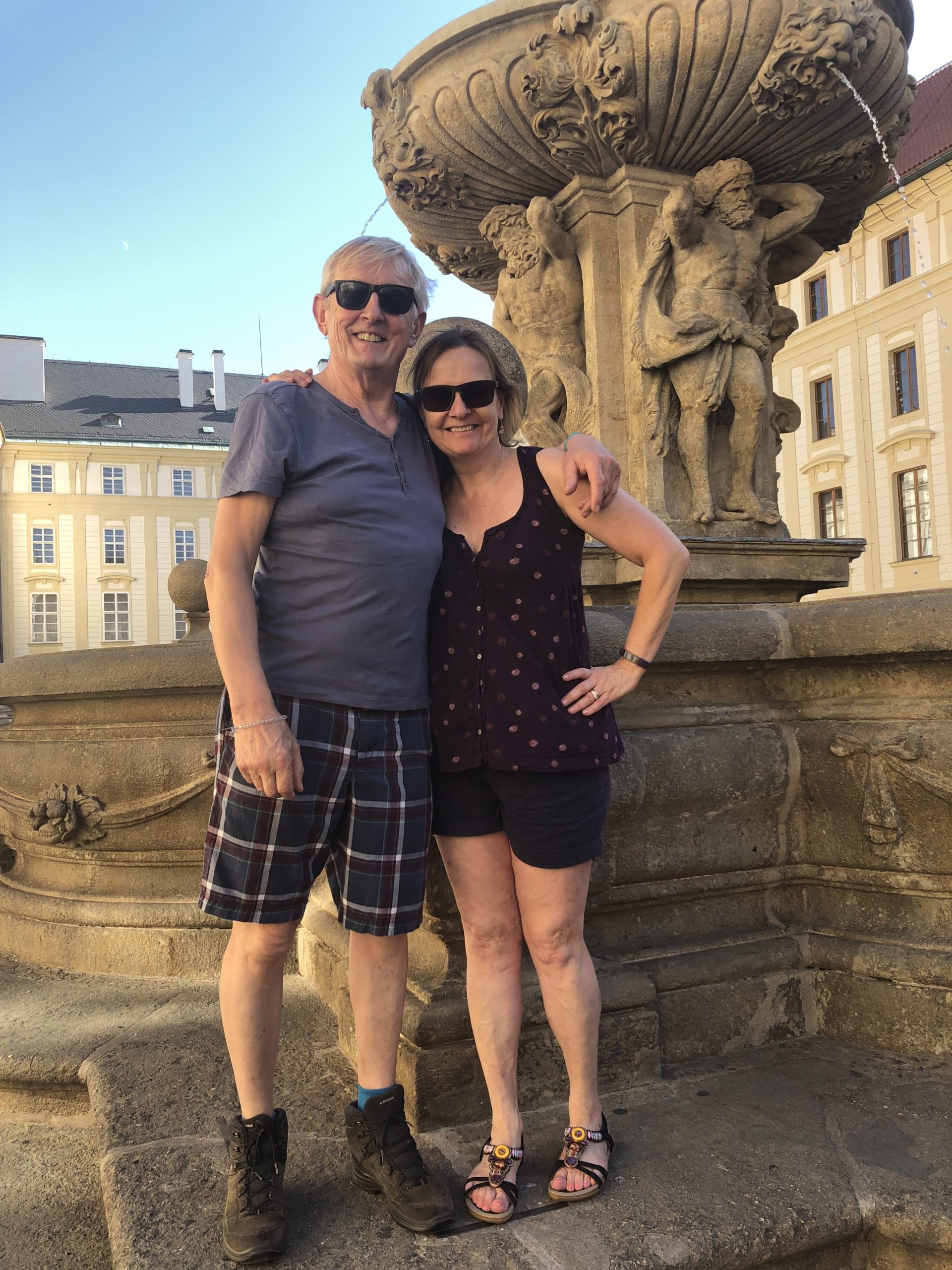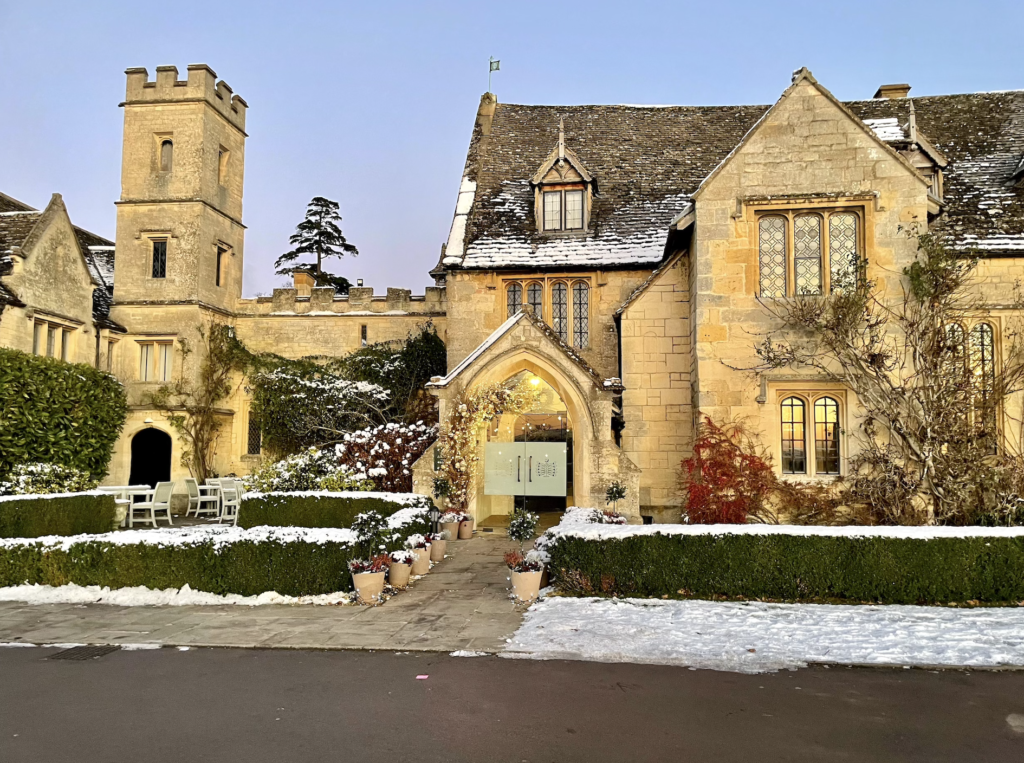
Ellenborough Park. Photo: © F.Hardy
Peter Welcome to our travel podcast. We’re specialist travel writers and we’ve spent half a lifetime exploring every corner of the world.
Felice So we want to share with you some of our extraordinary experiences and the amazing people we’ve met along the way.
Peter With its glorious terraced houses, tree-lined promenades and grand public buildings, Cheltenham in Gloucestershire is said to be the most complete Regency town in Britain.
Of course, it’s best known these days for horse racing. The four-day Cheltenham Festival that takes place each March has prize money that’s second only to the Grand National and Aintree. The meeting attracts some 70,000 racegoers each day and in 2020 it proved to be one of the biggest spreaders of Covid when the organisers, perhaps unwisely, went ahead with it at the start of the pandemic.
But there’s much more to Cheltenham than just horseplay. The magnificent five-star Ellenborough Park Hotel, located barely a furlong away from the fabled turf, was once a manor house that dates back to the time of Henry VIII and beyond, and cloaked in a dusting of snow, first impressions were just magical.
Felice This huge, beautiful building with Cotswold stone, Tudor, lots of turrets and mellow stonework. Lots of extra bits and outbuildings and all looking very beautiful. We came and sat down in the Great Hall…
Peter Lovely Tudor fireplace with a roaring log fire, an almost life-sized portrait of Katherine Parr. It’s certainly a splendid room full of pretty eccentric things – there’s a massive harp in one corner.
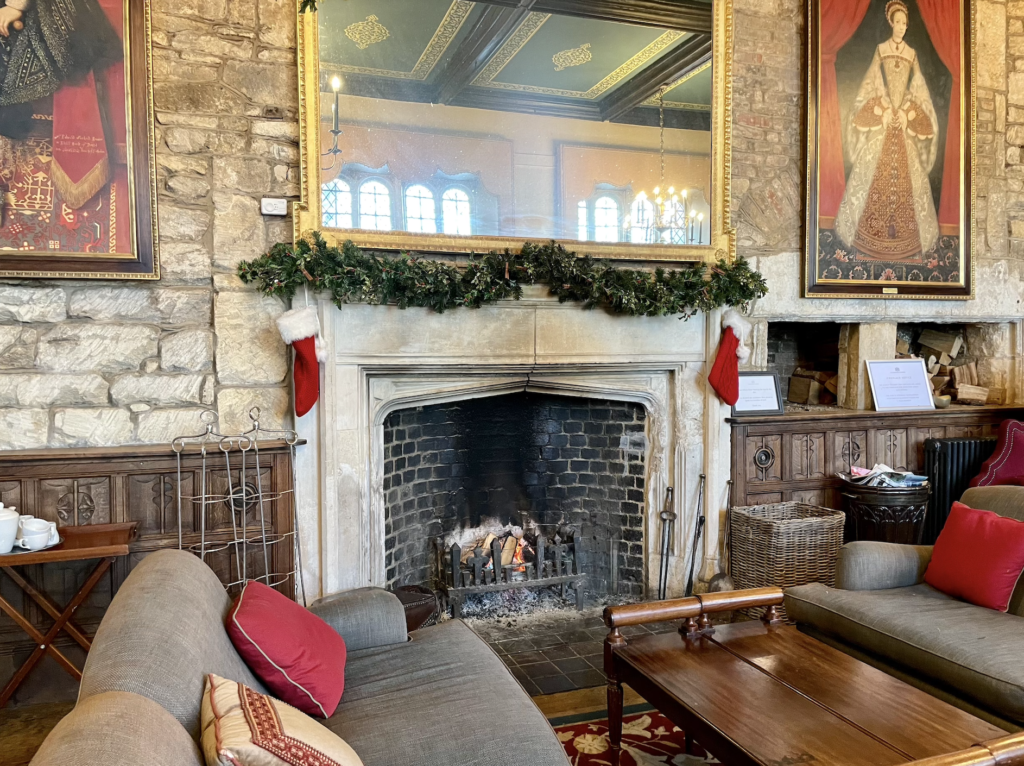
Portrait of Katherine Parr in the Great Hall. Photo: © F.Hardy
Felice A big tapestry-style rug on the floor, comfortable sofas that you literally sink into. And it all looks very nice: high ceilings, lots of beams, wooden galleries, very Tudor, mullion windows with stained glass.
Peter Ornate candelabras.
Felice Very high ceilings, which is quite difficult in this in the very low temperatures at the moment, difficult to heat. We’re in what I think is a dog friendly room. We brought our little dog with us and the room came with a crate. We don’t use one of those for our dogs, but there’s also a dog bed, dog food and treats. And when we booked in, we were asked for our dog’s name, which we thought was quite unusual. But on arrival there was a wooden carved dog bone with his name on it and all sorts of thing: dog poo bags, you know, you name it, you didn’t have to bring anything with you for your dog.
Peter Five-star hotels that are dog friendly are really rare. You can often find somewhere to stay with a dog, but a five star that actually welcomes dogs is extremely unusual.
Felice We haven’t taken the dog to the spa, though.
Peter Yes, you said they have a dog spa.
Felice We’ll find out more later. As I said, we’re in one of the outlying buildings, which is slightly annoying in the cold because you’ve got to trudge through the snow to get to the restaurant, the spa and anything else in the main building. So if you’re staying in winter and it is cold, I suggest asking for a room in the main building. But the rest of the year it would be lovely to be in an outlying building, especially in a dog-friendly room with its own completely dog-proof garden, which is great. There’s a choice of two restaurants the main restaurant and the Horsebox.
Peter It’s a sort of brasserie restaurant.
Felice And that’s where we’re supposed to go with the dog. But that was actually closed today. So we went into the main restaurant and that was fine with our little dog; not sure how it would be with a big dog. And there’s a bar where we had cocktails. We had breakfast this morning, a very good breakfast in the main restaurant with a buffet and lots of different choices for cooked breakfast. And even our dog was brought a bowl of water and a full bowl of treats, which we thought was a little bit much.
Peter Well, he didn’t. He thought it was great.

Some of the outer rooms of the hotel. Photo: © F.Hardy
Peter We’ve been fortunate enough to meet up with Kevin, who works in the hotel and has a deep knowledge of the building and its extensive grounds. So, Kevin, you know all about the history of the hotel. Tell us about it.
Kevin So we’re now in the Great Hall. It was built in 1485, and it was done by a man called Thomas Goodman, who was a tenant farmer. He noticed the way the light hits the land, and that’s what made him attracted to it.
Peter So we’re going through a sort of grand Tudor portico with beautiful panelling.
Kevin This is again, 1485, and you can see the initials of Thomas.
Peter And then we’ve got portraits of Katherine Parr and the third Duke of Dorset, I think on the wall there.
Kevin Katherine Parr is buried up the road in Winchcombe. That’s why she’s here. And this is Richard Sackville. He’s here for ironic reasons. During races, we ran vehicles right through the fields down to the racecourse. We’ve got a very strong affinity with Cheltenham Racecourse, so a lot of our guests are racegoers and they spend a lot of money on racing. So this man lost lots of money gambling. So he’s here to remind our guests just to be a little bit careful.
Peter 500 years later.
Kevin Yes, exactly.
Felice When do the races take place?
Kevin Lots of people think we only have won on race, and that’s in March. That’s the famous one, that’s what people think…that’s all there is, but in fact we have about seven races. Obviously in the wintertime, because it’s steeplechase, the ground needs to be soft. During the Civil War, there were lots of skirmishes around here, lots of fighting. And this door….
Peter We’re talking about the front door of the of the hotel..
Kevin… is believed to be from that time. And these are musket holes and they think it was maybe Oliver Cromwell who did it. So also, if you look on here, if I can find it, you can see the word M. That’s for Mary, the Mother of God, to protect people from witches. So there’s really a lot of history in this door.
Peter Let’s move on and have a look around the rest of the hotel.
Kevin Yes, of course.
Peter The hotel has had an amazing history over the centuries. During World War II, the stables were supposedly used by the RAF for the manufacture of specialist parts for hurricane bombers. But essentially it remained a family home with various aristocratic owners until 1947, when it became a girls’ school. A brief sporty rival to famous Cheltenham Ladies College down the road.
When the school closed in 1973, it first became a hotel. The current owners bought it in 2008 and they set about restoring the building and its 90 acres of grounds to its former glory. This included knocking down a lot of 1970s additions and building an outdoor swimming pool that’s heated to a comfortable 29 degrees. And of course, a dog spa.

Photo: © F.Hardy
Felice Actually, for anyone picturing doggy massages and four-legged hot stone treatments, the Paw Spa comes as a bit of a disappointment. It’s a place for washing down your muddy dog, really, But as a notice informs owners. ‘Check out our boot room where a basket of grooming goodies is located from shampoo and towels to treats. We have everything your pooch needs for a little pampering.’
Peter Well, now we’re going down to Cheltenham itself. Now, back in 1788, King George, III and Queen Charlotte took the waters here and set the seal on the town’s future as a tourist destination. But we’re heading for Pittville, the 19th century new town, if you like. The urban extension built by a businessman, Joseph Pitt, who saw its potential as a centre of wellness.
The main feature of this is the Pittville Pump Room, a magnificent spa building with a gigantic domed ceiling and an aspect fringe with ionic columns that stretches through scenic gardens and a giant lake right into the town centre. In the 1800s, the menagerie here was world famous. One visitor recorded seeing a stupendous elephant swimming in the lake. We met up with Jordan and Rachel from the Cheltenham Trust, which runs the place.
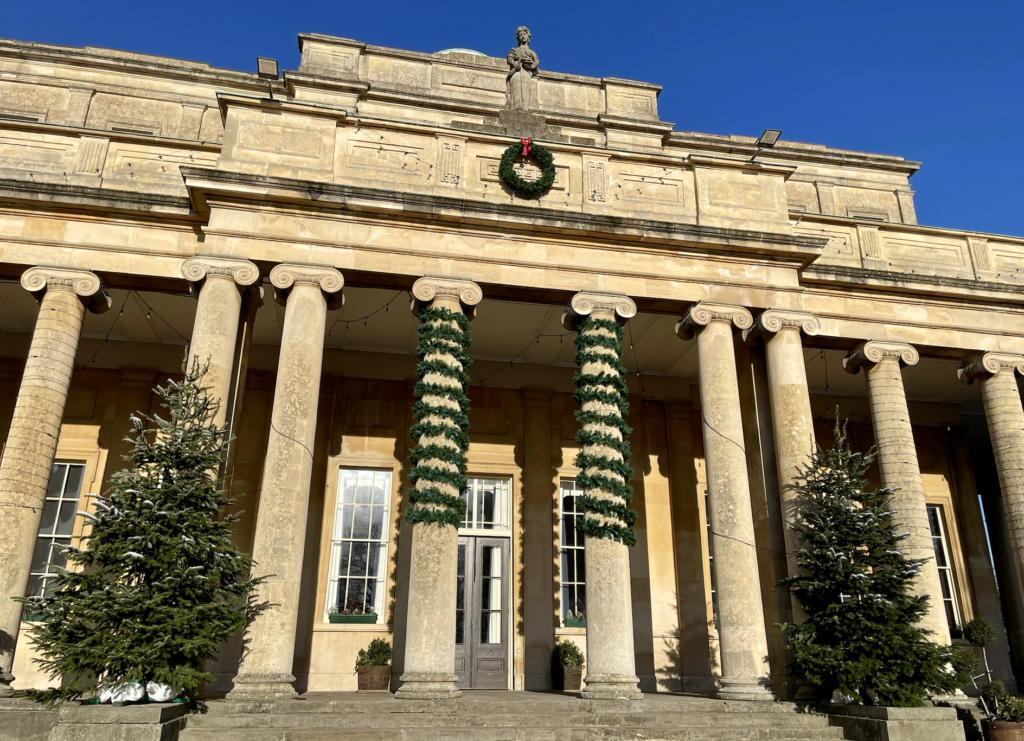
Pittville Pump Room. Photo: © F.Hardy
Jordan So Joseph Pitt commissioned the building of the Pittville Pump Room. Obviously the idea was to bring visitors to Cheltenham to taste the spa water. Building work started in 1825 and the work was completed in 1830.
Peter So we’re talking about the same period as Bath was at its height the main Regency period?
Jordan Yes. So a lot of, as we all know, spa water was booming. It was the thing to go and try. So that was the market that they were trying to get into
Peter Is the water good here? The water in Bath, I have to say, is pretty unpalatable.
Jordan It’s about the same. I think we’ve all started to realise that it might not have been the nicest water to drink, whatever the properties may have been – or are.
Felice Can you still taste the water here?
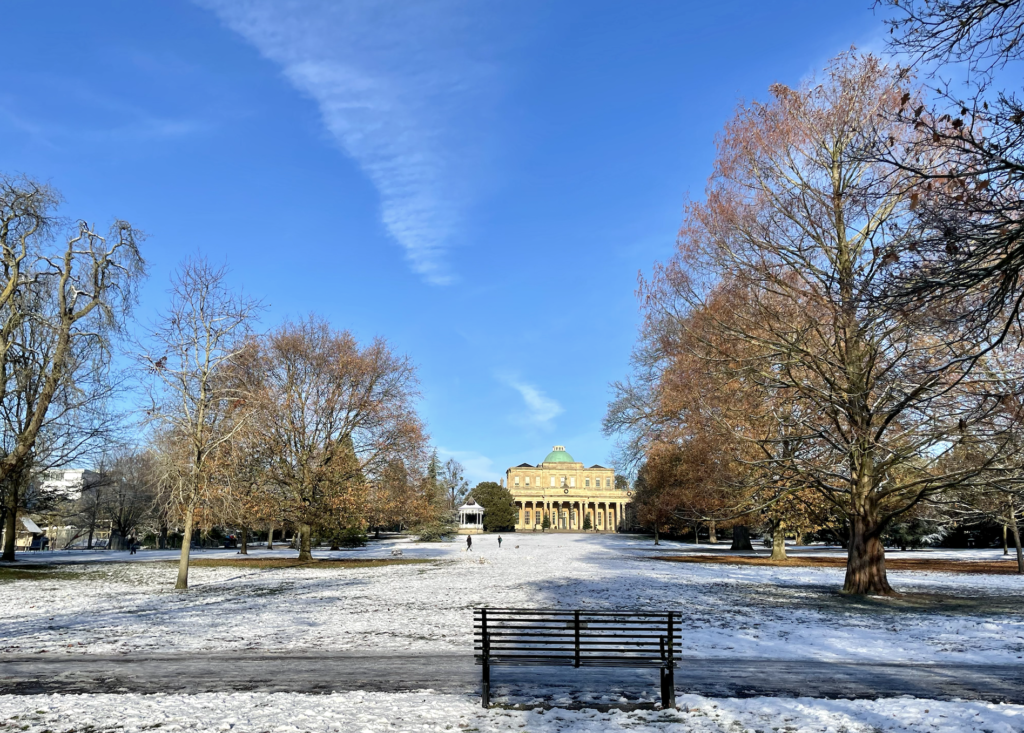
Photo: © F.Hardy
Jordan Unfortunately not. The minute the pump is currently undergoing maintenance due to the COVID 19 pandemic, there was obviously no one monitoring or looking after the building so unfortunately we just still like the process of getting it back operational.
Peter It’s an events venue now more than anything else?
Jordan Yes, so now it’s more of an events venue so it can seat about 400 people with an orchestra or around 600 people standing, and all manner of events from, like I say, orchestras, choirs, spoken word. So yes, all manner of things here at the moment, weddings as well. So any kind of corporate functions, dinners, all the way to weddings and even wakes.
Peter So here we have the pump.
Jordan Yes. These are the two levers that would have been used to pump. And then from down at the bottom underneath goes straight down all the way through the floor, into the cellar, and then into the ground.
Felice So is the water warm that comes out warm, or cold?
Jordan It’s cold. Well, it’s ground temperature. So normally cold. But unless we have another crazy heat wave.
Felice The flowers – what are they made out of? Plaster flowers, gold and white, all the way round the domed ceiling, inside the dome ceiling.
Rachel At the moment it’s gone back to how it was in history, and especially since Covid, the building’s become a major part of the community. So as well as private events…when it’s not a private event, we open with a heritage trail so people can come in and there’s different stations where they can read the history.
But also multiple times a year we do free community events because we’re the Cheltenham Trust who help run the building. It’s like we’re a charity, it’s part of what we do. So like we did the Queen’s Jubilee celebrations, we did a Christmas light switch on a few weeks ago. We do lots of children’s free activities during holidays, so it’s just a hub where people gather and that’s what we want to make it more and more, especially during 2023.
Felice Is it popular for that sort of thing?

The lake in Pittville park. Photo: © F.Hardy
Rachel Yes. So during the Queen’s Jubilee, I think we counted around 10,000 people in the park and here, because we’ll use the entire park as well.
Peter Jordan and Rachel, thanks for the tour. Now we can’t do full justice to Cheltenham in a single winter’s day, but we’re going to stroll through the gardens past that lake – no elephant present today, I’m afraid – into town to a very special but outwardly unassuming house: number 4 Pittville Terrace.
Not everyone knows that Gustav Holst, the world renowned composer….his most famous work, of course, was The Planets…was born here on the 21st of September 1874. But while he was unquestionably its most famous inhabitant, the Holst Victorian House is a living museum to the people who made it their home after it was built in 1832, from the Williams sisters in the 1840s to the Von Holsts in the 1870s to a Colonel Manners in the 1890s who retired here to Cheltenham from a career on the Indian subcontinent.
The house has been restored to how it would have been in Holst’s day, a treasure trove of Victoriana tucked away in its four-storey terraced house that brings a whole era to life. Lucy Moriarty, the learning and conservation manager, and volunteer Paul Trevel, told us all about it.
Felice We’ve just been looking round and upstairs is all Gustav Holst Museum and downstairs seems to be more the Victorian Museum.
Lucy Yes. So what we’ve done is we’ve tried to keep the house to the time period when Holst would have lived here, apart from the two ground floor rooms where you’ve got his piano and we’ve got some of his manuscripts on display. We’ve kept the upper stories and the lower floor of the house to what it would have been like when he lived here.
Felice It’s fascinating, all the little cooking things downstairs. There are cookery courses there for children as well.
Lucy Yes. So we can light the fire in the range and bake drop scones and biscuits, and at Christmas we make mincemeat following Mrs. Beaton‘s recipes. The house became a museum in 1974, which was 100 years after Holst lived here. Yes, the name Holst is Latvian; one of his grandparents came over from Riga. He decided that he would like to serve in the First World War and, unfortunately, his health wasn’t good enough for that to happen. But he was able to play music to the forces out in Salonika.
Felice And during his career he was a teacher, wasn’t he? A music teacher?
Lucy Yes. He ended up teaching music at St Paul’s Girls School in London.
Felice And the house, we’ve just looked round it and it’s absolutely lovely. I mean, the details of Victorian life… are any of the things actually his or from his family?
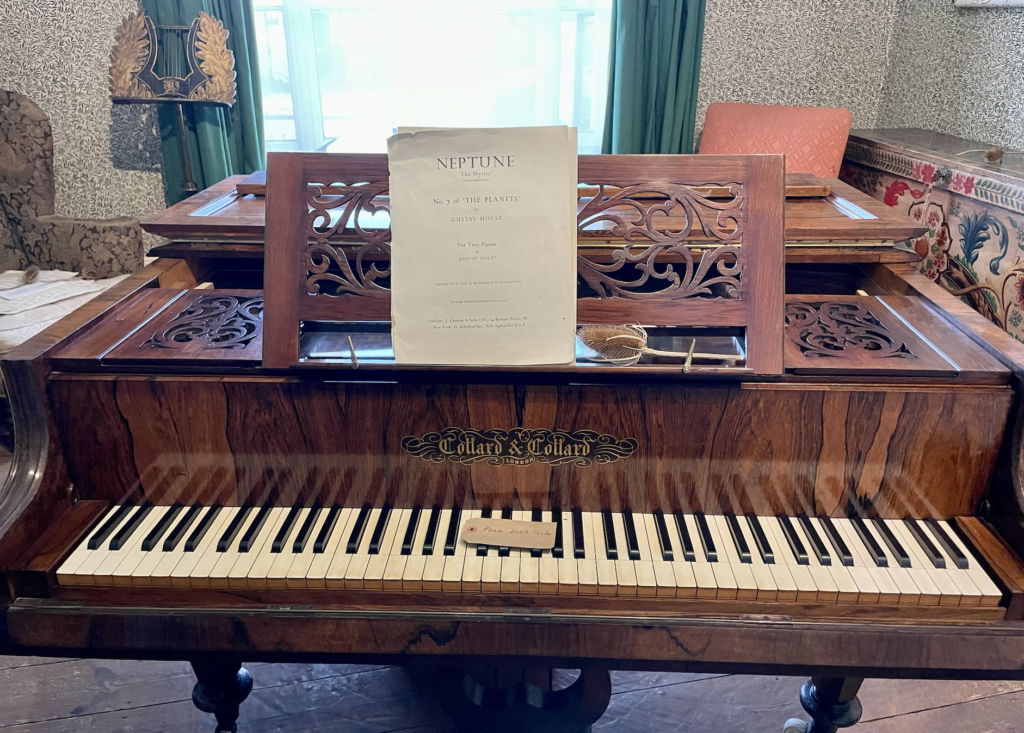
Gustav Holst’s piano. Photo: © F.Hardy
Lucy Only the piano we know was used by him. Everything else is how the curator Laura imagined it might have been when he lived here.
Peter A lot of sheet music of his as well.
Lucy Yes, we do also have lots of his original manuscripts.
Felice My favourite room’s the nursery. It’s absolutely lovely.
Lucy Yes, it’s my favourite room as well. In the nursery we’ve got an open fire because that’s what they would have had there. We’ve got a lovely selection of vintage toys that visitors can try out when they come in. Some sample outfits that Victorian children might have worn, and what is amusing to a lot of people is that a Victorian boy would have worn a skirt or a dress until they were five.

The nursery. Photo: © F.Hardy
Peter So and now we’re sitting in in the kitchen, in the basement, and there’s still actually a working stove in here, isn’t it?
Lucy Yes, we’re very lucky to have a working range in here. So we usually have the fire lit and unfortunately we don’t today, but we like to light the fire on a cold day and quite often we bake drop scones on it, or maybe some biscuits.
Felice And I hear that children can come in and have cookery lessons?
Lucy Yes, we do. We have schools visits for children where they can come in and make mincemeat or again drop scones. Sometimes we open up at the weekends and we have our resident Victorian cook in here demonstrating some of Mrs. Beaton’s recipes.
Peter And you’ve got every household implement from a carpet beater to a mangle to all sorts of weird and wonderful knife cleaners. That’s your interest, knife cleaners?
Paul Yes, indeed. I got interested in knife cleaners during lockdown, actually, because we were asked…
Peter It’s a specialist subject.
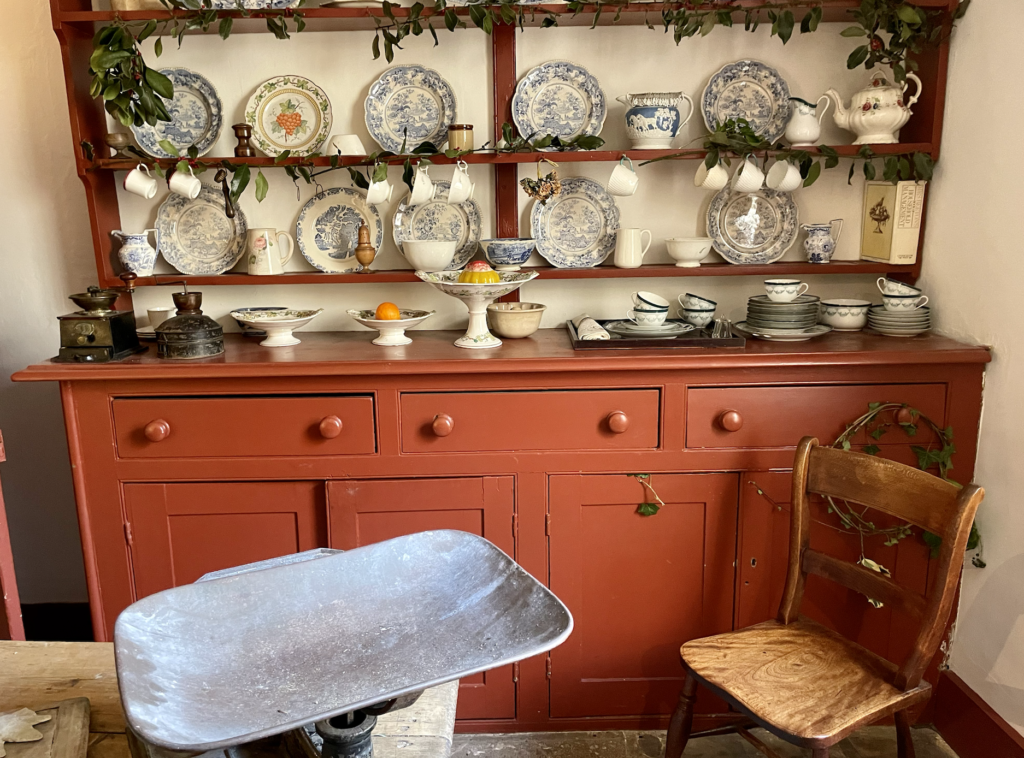
Kitchen. Photo: © F.Hardy
Paul Absolutely. Yes. But we were asked to nominate objects of interest in the museum to put on the website and I think in the magazine, and I chose to write a paragraph about the knife cleaner. So I did research on it, and then I found a couple of knife cleaners on for sale on eBay, I think it was. So I bought them. And one is bottom-of-the-range wizard knife cleaner for 6 1/2 p.
Peter 6 1/2 d, I think it is.
Paul Sorry, a 6 1/2 old p, that’s right, old pence. And the other is a middle-of-the-range one which looks a bit like a mangle. But when you look at the gearing on it, it clearly isn’t a mangle because the rollers would rotate the other way if it was a mangle and pull the pull the stuff through it, rather than just rubbing together against each other. So, yes, I’ve got a thing about knife cleaners.
Peter There’s certainly every possible gadget you can imagine in here.
Felice And the food is quite realistic and it looks quite horrible…some of it. There’s a pie that’s open and I don’t know what that would have been, what sort of pie that would have been. But it almost looks like it has liquid in it and it might be hot.
Peter It’s not one I personally like to eat, but I expect a lot of Victorian food wasn’t something you’d like to eat, forgive me, Mrs. Beaton.
Paul I did some children’s activities down here a week or two back, and a couple of weeks later I came in to do the front of the house and I had got some children and I wanted to demonstrate the weighing scales to them. I was looking for something to weigh and there were some eggs up on the side there that I thought were pretend eggs until I put one on the scale and it broke. It was a real egg.
Felice In the sink, there’s washing up, which looks pretty disgusting with dirty water. And in fact the dirty water is solid.
Peter There’s a bucket when they’ve slopped out the floor to which is full.
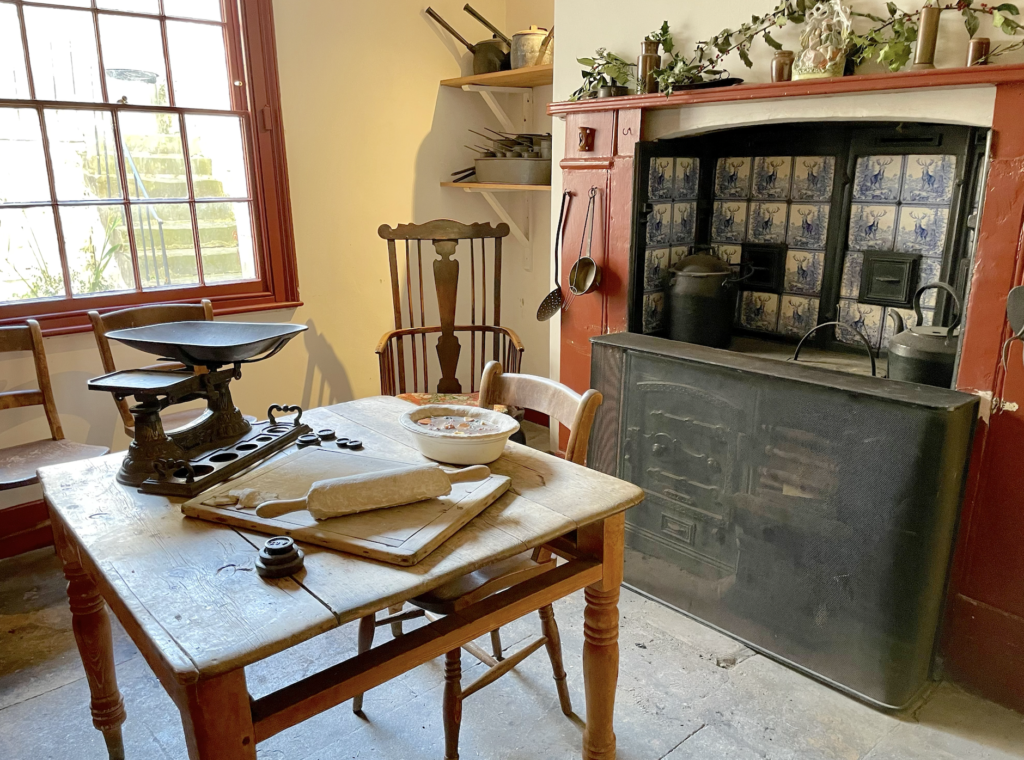
Kitchen table and range. Photo: © F.Hardy
Felice So it’s all pretend, very realistic.
Peter It looks very realistic. It’s very good. You’ve got just about everything here. We went to museum in Singapore, of a shanty town in Singapore, where they had smells of the period, too. And they were quite disgusting, as you can imagine.
Paul Yes. We’ve been talking actually here about improvements that we might make. A number of people have been to look at museums elsewhere in the country like Bath, and I think they went to Bletchley Park to look for ideas. We’re considering some of these things that create an environment, if you like. But it’s quite difficult to do in a way that is not intrusive I feel.
Peter I think particularly with smells, that could be very difficult.
Paul I think you’re right.
Felice I think you could have a Victorian bathroom or the outdoor loo.
Peter Well, you have the idea. No, you’re going to get too close.
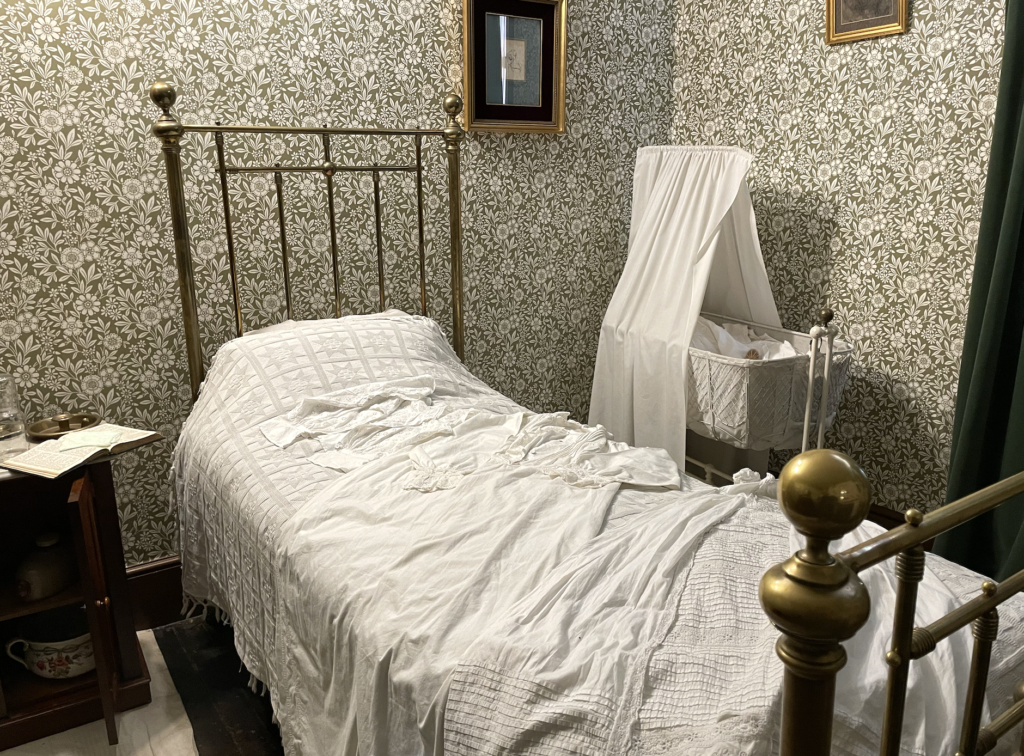
Bedroom in the Holst House. Photo: © F.Hardy
Paul But where’s the bathroom in a Victorian house? They didn’t have them.
Peter No, it’s in front of the stove isn’t it. Tin baths.
Paul It would have been a tin bath. You see it wouldn’t have been a bathroom.
Peter The only loo is an outside one and very cold on a day like today when it’s minus seven degrees.
Paul I often say to people is: the thing to think about when you’re here is not what is in here, but also what is not in here. There’s plenty of things that are not in here that you’d have every day today.
Felice I suppose if you wanted to make it even more realistic, you could have the genuine lighting. But that would be rather dark, wouldn’t it?
Peter It might be a bit dangerous, too.
Lucy Did you know that we have plans to change next year to restored gas lighting. So we’ve bought some original fittings and then they are fitted with LEDs to make it lit like gas lighting.
Peter It’s a good idea. If you need a reason to come to Cheltenham, this is as good as any, I tell you. It’s a wonderful place to come.
Felice If you’d like to know more about the hotel, go to EllenboroughPark.com – you can find details of what’s on at the Pump Room at PitvillePumpRoom.org.uk and for more about the Holst Victorian House. It’s HolstVictorianHouse.org.uk.
Felice That’s all for now. If you’ve enjoyed the show, please share this episode with at least one other person! Do also subscribe on Spotify, i-Tunes or any of the many podcast providers – where you can give us a rating. You can subscribe on Spotify, Apple Podcasts or any of the many podcast platforms. You can also find us on Twitter, Facebook and Instagram. We’d love you to sign up for our regular emails to [email protected]. Until next week, stay safe.
© Action Packed Travel

- Join over a hundred thousand podcasters already using Buzzsprout to get their message out to the world.
- Following the link lets Buzzsprout know we sent you, gets you a $20 Amazon gift card if you sign up for a paid plan, and helps support our show.


